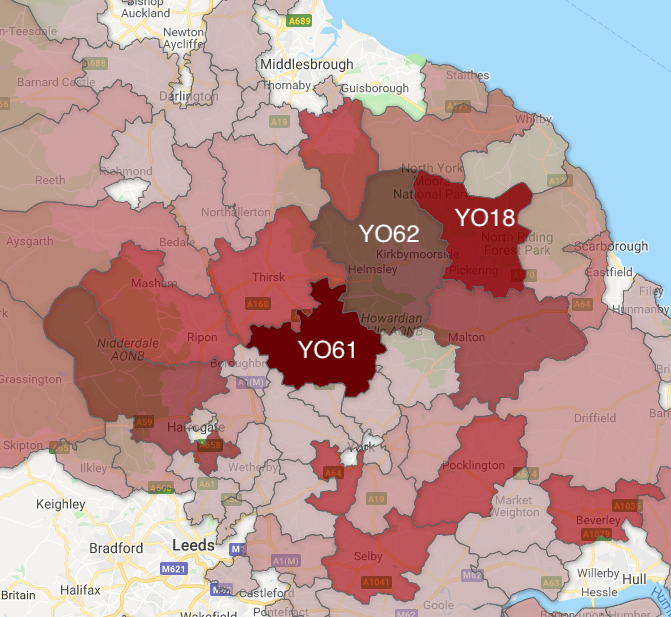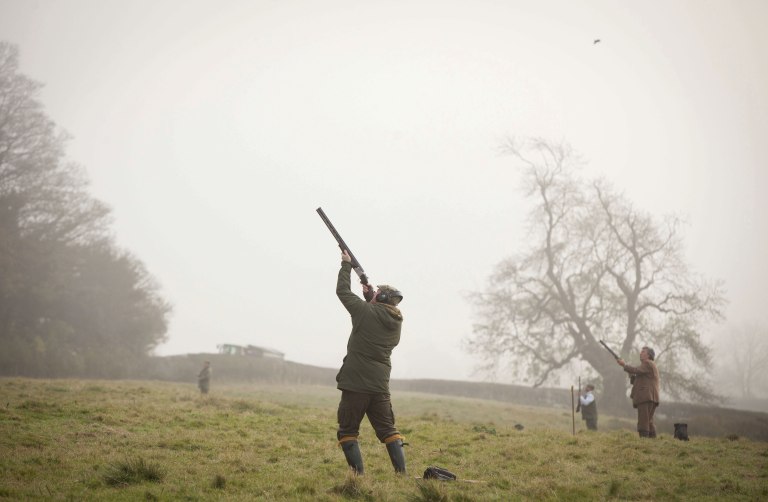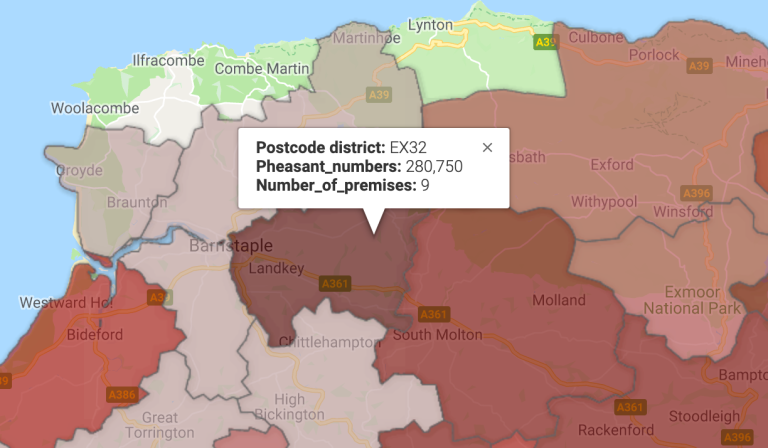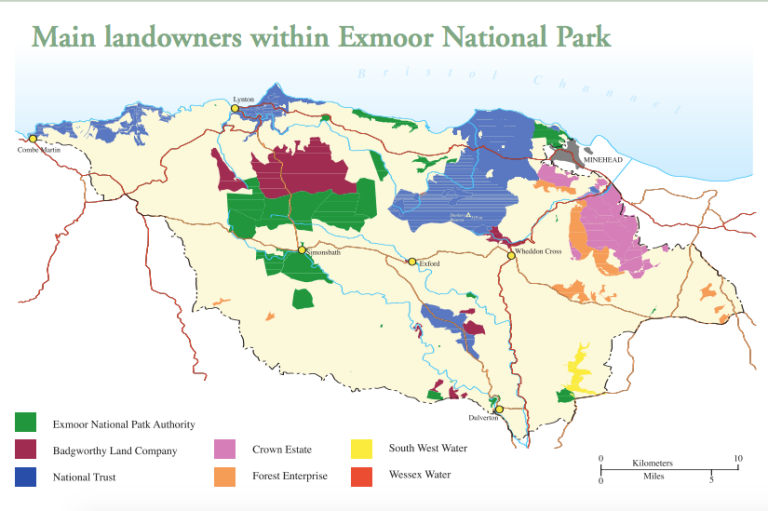This post is by Guy Shrubsole.
Go for a drive down a country lane and you’re almost certain to encounter a pheasant, most likely as it leaps, kamikaze-style, into the path of the oncoming car. Pheasants are a non-native species in Britain, introduced for shooting; and though we tend to think of them as a harmless (if rather stupid) species, their numbers are now vast – a staggering 35 million are released in the UK every year (20 million of which are in England, as we’ll later see). A recent study showed the biomass of introduced pheasants outweighed the biomass of all wild bird species in the UK. So who’s releasing all these pheasants? What’s the ecological impact of doing so? And who owns some of the estates responsible? Who Owns England decided to investigate.
The ecological impact of pheasant releases
To be clear from the outset: the science on pheasant releases is complex, and doesn’t cut all one way. Many pheasant shooting estates invest in planting cover crops for pheasants that also provide food for wild bird populations. Figures from the Game & Wildlife Conservation Trust (GWCT) suggest that shooting estates have planted thousands of acres of woodland copses and hedgerows for pheasants to shelter in – creating lots of space for other wildlife in the process.
Nevertheless, the sheer scale of the pheasant population nowadays gives many conservationists cause for concern – as does the rate of population increase. GWCT data shows a nine-fold increase in pheasant releases since the 1960s, whilst the BTO’s Breeding Bird Survey shows a nearly 50% increase in the breeding population of feral pheasants over the same period:

And there is increasing evidence that this weight of pheasant numbers is having negative ecological impacts – much of it gathered by the GWCT themselves: with high densities of pheasants shown to alter the structure of hedgerows, cause significant changes in invertebrate communities, and have long-term negative impacts on woodland species diversity and structure. This begs more questions: what’s this outsize population of pheasants doing to other parts of the food chain? What’s the impact been on predator populations? Is there any link between the vast increase in pheasant numbers since the late 1960s and the 56% decline in farmland birds observed since 1970? Part of the problem in answering such questions is the lack of granular data: we just haven’t known where the largest releases of pheasants have been taking place, and which estates are likely doing so. Until now, that is.
Here be pheasants
Pheasants have a truly bizarre legal status: when they’re reared by estates, they’re classed as livestock; when they’re released for shooting, they magically become wild birds. Pheasants’ classification as livestock grants shooting estates some tax benefits and exempts them from certain planning controls; but it also means they must register the number of pheasants they are rearing with the government.
This information used to be collected by the former Animal Health and Veterinary Laboratories Agency (AHVLA), but the data they published on gamebird numbers between 2011-2013 was national level only, and combined figures for partridges and pheasants. However, their annual reports also contain some intriguing ‘heatmaps’ showing gamebird densities, which start to give clues as to where the biggest shooting estates might be – this one is from 2013:

But how to get at this more detailed data? In 2014, AHVLA became the Animal and Plant Health Agency (APHA). I decided to submit a Freedom of Information request to APHA requesting the total number of pheasants reared in England in 2018, broken down by local authority area and by postcode district. At first, they refused to disclose the more detailed postcode district data, but released county-level pheasant numbers, which you can view in this Google Sheet here.
This data shows there were 20,756,012 pheasants reared in England in 2018 across 3,907 premises, and that 770 premises in just 4 counties account for nearly a third (32%) of this total:
- North Yorkshire – 2,645,295 registered pheasants
- Devon – 1,539,312
- Cambridgeshire – 1,280,095
- Norfolk – 1,127,320
But what about more granular data? I appealed APHA’s refusal, and they relented…
The postcode district with a million pheasants
APHA eventually released to me data on the number of pheasants in England broken down by postcode district. Here’s their FOI response, and the data in PDF format; and here’s the dataset, slightly cleaned up, in a Google Spreadsheet.
Some startling things leap out from this:
- One postcode district, YO61 in North Yorks, contains over a million pheasants!
- There are 11 postcode districts containing over 200,000 pheasants each.
- These top 11 postcode districts account for 3.6 million pheasants, spread over just 149 premises / shooting estates.
- In other words – there is a high concentration of pheasants in a small number of areas, and over a small number of estates.
Here’s the top 11:
| Postcode district | Pheasant numbers | Number of premises |
| YO61 | 1,045,300 | 12 |
| YO18 | 377,700 | 8 |
| PR3 | 357,857 | 20 |
| OX5 | 284,650 | 5 |
| EX32 | 280,750 | 9 |
| SP5 | 233,550 | 31 |
| YO62 | 230,650 | 24 |
| TN19 | 213,300 | 5 |
| NG34 | 209,750 | 9 |
| TA20 | 205,900 | 12 |
| NR12 | 200,080 | 11 |
To get a clearer picture of pheasant densities across England, and start honing in on the likely biggest estates, I turned the dataset into a map – by combining it with a postcode polygon dataset derived from OS & Royal Mail data by OpenDoorLogistics. Here it is in Google Fusion Tables, and here’s a screengrab below:

Attribution: Copyright © 2015 by OpenDoorLogistics (www.opendoorlogistics.com). Contains Royal Mail data © Royal Mail copyright and database right 2015. Contains National Statistics data © Crown copyright and database right 2015.
Identifying shooting estates in these hotspots
Armed with this data on where the highest concentrations of pheasants are makes it a lot easier to start tracking down large shooting estates. I’ll focus here on examples of estates I’ve identified in two clusters: 1) North Yorkshire (postcodes YO61, YO62 and YO18); and 2) Devon around Exmoor (EX32 and nearby).
1) Pheasant shoots in North Yorkshire

YO61, the postcode district with over a million pheasants in it belonging to just a dozen estates, lies on the edge of the Howardian Hills AONB in North Yorkshire. Oddly, shooting website GunsOnPegs.com doesn’t list any pheasant shoots within that postcode district. But searching the area on Google Maps brings up at least one likely name: the Newburgh Priory Estate. This is the 5,889-acre estate of Sir George Wombwell, 7th baronet (his ancestor fought in the Charge of the Light Brigade). It’s also a large pheasant shoot, with “no shortage of birds”, according to ShootingUK. This Highways Act map of the estate, outlined in red, gives a sense of its scale (some is also missing off the top):


A pheasant shoot in progress at Newburgh Priory. Source.
In neighbouring YO62 reside a mere 230,650 pheasants, spread over 24 premises. This postcode district covers both the Howardian Hills AONB and part of the North York Moors National Park. Large shooting estates here include the 3,000-acre Hovingham Estate of Sir William Worsley, baronet. GunsOnPegs states that pheasant shooting at Hovingham “takes place within the Estate woodlands”. Sir William was not long ago appointed the government’s Tree Champion; let’s hope he’s taking heed of the GWCT’s research showing the negative ecological impacts that high densities of pheasants can have on woodlands…
Other pheasant shoots in YO62 listed on GunsOnPegs include the Ravenswick Estate near Kirkbymoorside (which has an intriguing, chequered history: the stately home was recently demolished and a fresh one planned by a mysterious new owner); and the 5,000-acre Farndale shoot, further north onto the moors.
It seems likely that some of the pheasant shoots in this part of the world belong to grouse moor-owning estates that dominate the North York Moors. For instance, the Spaunton Estate of Moorland Association committee member George Winn-Darley offers both grouse and pheasant shooting. And in the adjacent postcode district YO18 (home to 377,700 pheasants in 8 premises), the Westerdale and Rosedale Estate of Carphone Warehouse founder David Ross also operates both grouse and pheasant shoots.
2) Pheasant shoots around Exmoor, Devon

EX32, on the edge of Exmoor in Devon, contains 280,750 pheasants over 9 premises. Within this postcode district lies the Castle Hill Estate, owned by the Fortescue Farm Partnership (they show up in the Section 31 declarations layer on our Who Owns England map). There’s nothing on their website to immediately suggest they’re a pheasant shoot; but GunsOnPegs has an entry for the ‘Temple Shoot’, which advertises itself as taking place on the Castle Hill Estate in North Devon. The estate appears to belong to Lady Laura Duckworth-Chad, daughter of the Countess of Arran and Conservative Peer the Earl of Arran. So, whilst many pheasant shoots appear to be run by smaller farms and businesses, at least some of the larger shoots are owned by the aristocracy.
One final example illustrates another, more modern driver of ever-larger pheasant shoots: the shooting syndicate. The Badgworthy Land Company is a major landowner and big shooting syndicate founded in 1926; Land Registry data shows it owns a huge 12,500 acres. Companies House records reveal the Badgworthy Land Company’s registered address to be within the EX32 postcode district – so any pheasants it’s rearing will likely be recorded by APHA as being within this district. But the land on which it rears and releases the pheasants is in fact further to the east, over on Exmoor, as the map below shows (source):

That suggests the APHA pheasant dataset is a good, but not perfect, guide to where the highest densities of pheasants are in England. Clearly more research is needed into who owns the largest pheasant estates, and what ecological impacts they’re having on the surrounding environment; but meanwhile, the numbers of pheasants rise and rise.
Will DEFRA fund such research? I wouldn’t necessarily bet on it:

A somewhat younger Michael Gove on a pheasant shoot. Source.

The Badgworthy Land Company does not own land per se but owns the Sporting Rights.
LikeLike
Heya! Thanks for this – my understanding from Land Registry records is that Badgworthy do also have freehold ownership of a considerable acreage – they show up in the Corporate & Commercial dataset (which is meant to only record freehold rights) as owners of 12,500 acres.
LikeLike
The person to ask is Hugh Thomas. I only know people who have given the BLC the sporting rights to their property. This was primarily aimed at preventing incomers from stopping hunts from crossing their land.
LikeLike
I have worked with Badgworthy on a number of occasions (HLS/CS related) – they own a large area, correctly identified by your research (primarily brendon common/cheriton ridge and surrounds).
The area they own sporting right for is much much larger (many 1000s of ha) in reality these ‘rights’ are probably not worth the paper they’re written on – I know a Moorland landowner (again via CS) who has basically told the hunt to f*ck off, the hunt (BLC backed) then waved their sporting rights in his face to which the landowner challenged them to try and take the matter to court – unsurprisingly they weren’t willing to do this since it brings very undesirable scrutiny on their practice of ‘hunting within the law’, and failure would invalidate the rest of their sporting rights.
Incidentally the BLC land agent is also the chair of the Greater Exmoor Shoots Association (GESA) – a vociferous and influential lobbying body for shoots on Exmoor, and the registered office of the BLC is the address at which the GESA chair’s offices are based. The hunting and shooting lot down here basically a lavishly moneyed and depressingly influential cabal (you’ll be astonished to hear), progressively destroying the landscape with hilltop factory farms pouring out millions of heavily medicated non-native birds. These same people very much have the ear of the national park authority, who are completely petrified of any national attention being paid to the gradually worsening ecological devastation being wrought by the shooting industry, and are sadly even more terrified of actually taking a position again the shoots.
Ah well, I’ll go and pick some beaks out of my car radiator………
LikeLike
– YO61/2 area – Rievaulx Sporting & Mount St John Sporting (postcode out of area), and many others.
– Note, many released birds are imported, which is why reared numbers are < released numbers
– British Trust for Ornithology (BTO) have been researching whether more released pheasants leads to more generalist avian predators, which may impact other species, but I don't know if their bird rearing dataset was as detailed as yours.
LikeLike
Must confess, I had naively thought pheasant shooting was a leftover relic of the Victorian era and bound to die out eventually – seems I couldn’t have been more wrong!
LikeLike
Reblogged this on Kitchen Counter Culture and commented:
I really don’t know what to think. I just cooked pheasant, from breasts bought from a small independent butcher in a small shop in a small village in mid-Wales, thinking about a food system of small players and traditional game as an alternative to industrial meats.( I made a lovely stir-fry with nettles and wild garlic, Chinese flavours. ) Yet, if you read this article, you’ll understand all the many issues surrounding these birds, related to general bird biomass, ecology, land ownership, and food supply. It’s chilling that this explosion of pheasant numbers, many more than can be eaten in this market, takes place at the same time as some people pushing for more industrial chicken sheds in the countryside: raising livestock birds for cheap meat, raising wild birds for the pleasure of the hunt and who compete with local birds in waning populations. You can’t drive around here in spring without seeing dead pheasants all over the road. Why did the pheasant cross the road? To make us aware of all these conundra.
LikeLike
Regarding pheasant shoots in the North York Moors, I’m pretty sure the Hawnby and Arden estate includes pheasant shooting along with grouse moor, and there’s another one nearby, Murton Grange. Then there’s Duncombe Park closer to Helmsley, and Pennyholme not far from Kirkbymoorside, towards Bransdale I think. No doubt there’ll be others.
You mention the Westerdale and Rosedale estate. That estate crosses several different postcode areas. I know one area of that estate where most of the release pens seem to be, so it would be interesting to know where their birds are actually registered to.
LikeLike
not sure if you have combined the game farms that are producing birds for other shoots, top news story on innocentbadger dot com (pheasant farm breeding stock liberated) also about 40% of birds are imported from France as day old chicks, apha can be very disingenuous about the true figures. Back in 2013 the data set with the heat map showed that 50 million game birds were present on Jan 1st 2013.
Well done with this, good work.
LikeLike
Reading the article in British Birds on the 20 million pheasants being released in one year you state, correctly, that they are “non-native birds”.
If under the Wildlife & Countryside Act it is illegal to release non-native species why is it OK to release Pheasants Red-legged Partridge???
LikeLike
Fascinating research: great work. I’ve just ordered your book. I’d like to know more about pheasant shooting in my native Scotland, especially Dumfries and Galloway. I think Andy Wightman (Green MSP) might have some research.
LikeLike
Exmoor is the smallest National Park in England ( 267 square miles ).
Due to its unique topography and beauty commercial shooting is exploding.
It is an open secret that Exmoor is now the global Mecca for gamebird shooting.
Facts: In 2005 760’000 pheasants and 170’000 red legged partridge had been released.
Since then numbers have doubled at least. In the same time the numbers of gamekeepers went up from 8 to over 80.
According the Game and Wildlife Conservation Trust in 2018 35 Million pheasants and 6 Million red legged partridge were released in the whole country.
The bag of shot birds is around 15 Million with less than 10% wild bred birds.
All released birds stem out of incubators but are called wild birds as soon as they jump their releasing pens.
About 40 – 45 % of the released birds are imported from France as very young chicks.
Breeding methods in France are under scrutiny and would not be allowed in this country.
LikeLike
A new game farm has illegally opened at Foresters Croft in Oathlaw Angus if anyone knows how to add this address to the map ?
LikeLike
Great work – I’d like to know more. At first hand it is morally indefensible to shoot pheasant. Would you do it to a cow? “Pull!”
LikeLike
A really interesting article and you are right to bring up the complexities of the issue. On the one hand the presence of shooting in this country does a huge amount to encourage conservation efforts in the countryside; you mention cover crops are planted, field margins encouraged, woodlands managed etc. The effect of this, to me anyway, seems quite clear when we look at our hedged and bordered fields compared to the open land approach adopted in Europe and the US, which is much more focused on maximising planted area. I know which I prefer.
Then there is the economic contribution to rural economies, many undervalue the importance of the industry to these communities, but around where I live (interestingly I note one of the most densely stocked areas on your map) almost everyone knows someone who benefits from the shooting industry.
That said, I could not agree more that stocking numbers need managing. Should shooting itself be done away with, NO, it provides too many benefits in other ways, but there is a point at which these benefits start to be eroded due to enormous numbers released by commercial shoots and this needs to be regulated.
It is very easy to be against shooting as a class thing. The reality is that the vast majority of shoots across the UK are small, run as syndicates or on small family farms, with people of all ages and classes attending, and yet the land is managed for these days.
Whilst many think the big shoots are run purely for the aristocracy, in my experience it is usually paying guns from Europe or the US, or city types coming out to the countryside. The current argument is that it is only the prospect of a high number of birds that attract these type of people, I suspect they would have just as rewarding a day shooting 150 birds as shooting 500, if 500 was taken off the table.
LikeLike
I live on the edge of a big commercial shoot in S Devon. I have been here only a few years but in that time have seen the number of pheasants released climb inexorably.
Farmland (which benefits from much public funding) which I formerly used to walk on with my dog is now out of bounds to me because the farmer has leased rights to the burgeoning shoot next door,
This is an important point: ordinary people are being denied access to land because of the greedy commercial activities of these people who have no real interest in ecology, sustainability, or anything else other than the bottom line – and in the case of the keepers, hefty cash tips from the wealthy punters.
Not only that, the keepers are often arrogant and aggressive. I have no doubt that they use poison and traps. They are spreading grain directly onto the soil and have to “humanely control” (sic) rats, just as they have to “humanely control” (sic) foxes.
I had a long conversation with a former keeper in Lincs this summer, and heard it all first hand.
He told me to watch out for my dog near the shoots because it was known to him that some keepers would leave out poisoned pheasant carcasses for foxes.
Nearby, south of Grantham, we know a keeper was shooting red kites.
I have few objections to low-key rough shooting for food, but this evil trade needs to be excised from our countryside.
LikeLike
Don’t know if this is of interest, but Birdsall Estate (Lord Middleton) in North Yorkshire, covers 12000 acres and releases 12ooo pheasants each year.
LikeLike